Text classification with CNNs and LSTMs
Contents
Text classification with CNNs and LSTMs#
In this notebook CNNs and LSTMs are applied for document classification. Here, the documents are IMDB movie reviews. The IMDB Movie Review corpus is a standard dataset for the evaluation of text-classifiers. It consists of 25000 movies reviews from IMDB, labeled by sentiment (positive/negative).
The main goal of the notebook is to demonstrate how different CNN- and LSTM architectures can be defined, trained and evaluated in tensorflow/keras. Hyperparameter-optimisation is not regarded, here.
Overview: BoW + Conventional ML versus Embeddings + Deep ML
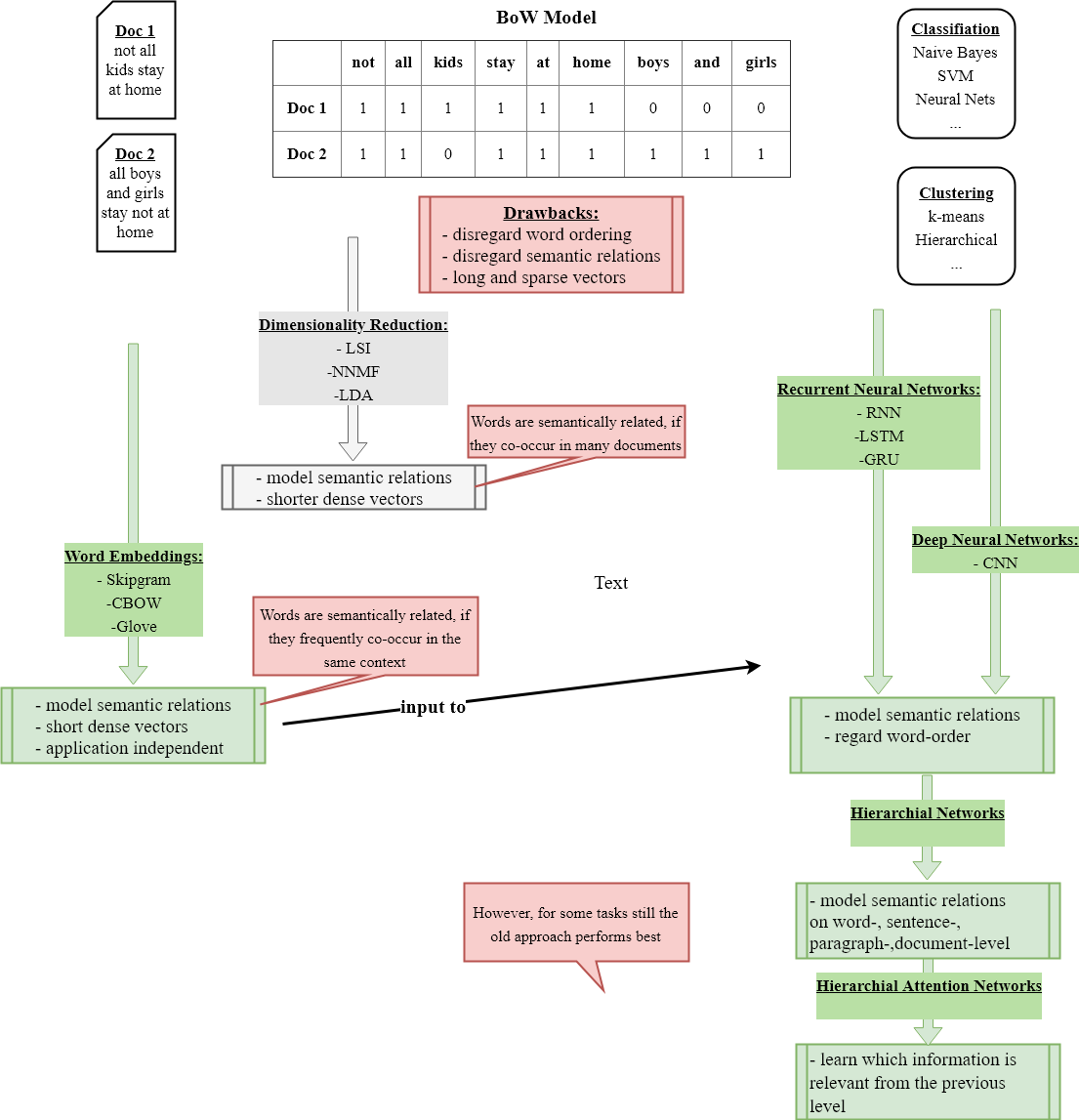
import numpy as np
from tensorflow.keras.preprocessing.text import Tokenizer
from tensorflow.keras.preprocessing.sequence import pad_sequences
from tensorflow.keras.utils import to_categorical
from tensorflow.keras.layers import Embedding
from tensorflow.keras.layers import Dense, Input, Flatten, LSTM
from tensorflow.keras.layers import Conv1D, MaxPooling1D, GlobalMaxPooling1D, Embedding, Dropout, Concatenate
from tensorflow.keras.models import Model, Sequential
from tensorflow.keras.datasets import imdb
MAX_NB_WORDS = 20000 # number of most-frequent words that are regarded, all others are ignored
EMBEDDING_DIM = 100 # dimension of word-embedding
MAX_EMB_WORDS=20000
Configure Word-Embedding Option#
The text-classification algorithms applied in this notebook, CNNs and LSTMs, apply word-embeddings at their input. Concerning the word-embeddings, there are basically two options:
Learn the embedding inside the neural network for a specific task, e.g. document-classification. In this case the first layer of the Neural Network (CNN or LSTM) is an
Embedding-layer. Like all other weights, the weights of this layer are learned from the given task-specific training-data. The layer’s output are the wordvectors.Apply a pretrained word-embedding, which has been trained on unlabeled data in advance, e.g. CBOW or skipgram
In this notebook, both options can be implemented. Moreover, for the second option 2 different pre-trained word-embeddings can be loaded: Glove or Fasttext.
In the code cell below one of these 3 options can be defined by setting the Boolean variables GLOVE and FASTTEXT:
GLOVE = False # Whether to use pretrained word-embeddings from GLOVE
FASTTEXT = True # Whether to use pretrained word-embeddings from Fasttext
USE_PRETRAINED = True if (GLOVE or FASTTEXT) else False
print(USE_PRETRAINED)
True
Access IMDB dataset#
The IMDB dataset is already available in Keras and can easily be accessed by
imdb.load_data(num_words,skip_top).
The value assigned to argument num_words defines how much different words shall be regarded. I.e. all words, which do not belong to the num_words most frequent words in the corpus are disregarded and marked by integer 2. Morevoer, the skip_top most frequent words are also disregarded. This implements stop-word filtering, since stopwords are usually the most frequent words.
The returned dataset contains the sequence of word indices for each review.
(x_train, y_train),(x_test,y_test)=imdb.load_data(num_words=MAX_NB_WORDS,skip_top=100)
print(len(x_train),'train sequences')
print(len(x_test), 'test sequences')
num_classes = np.max(y_train) + 1
print(num_classes, 'classes')
25000 train sequences
25000 test sequences
2 classes
First 50 tokens of first training document:
print(x_train[0][:50])
[2, 2, 2, 2, 2, 530, 973, 1622, 1385, 2, 458, 4468, 2, 3941, 2, 173, 2, 256, 2, 2, 100, 2, 838, 112, 2, 670, 2, 2, 2, 480, 284, 2, 150, 2, 172, 112, 167, 2, 336, 385, 2, 2, 172, 4536, 1111, 2, 546, 2, 2, 447]
As can be seen from the output above, the reviews are already presented as sequences of word-indeces. For training and validation of the document-classifier, this representation is fine. However, for understanding these documents one can calculate and apply the corresponding inverse word-index as shown below:
wordIndex=imdb.get_word_index()
inverseWordIndex=dict([(value,key) for (key,value) in wordIndex.items()])
inverseWordIndex[1]
'the'
len(wordIndex)
88584
First 10 entries of the word-index:
import operator
wordIndexList = sorted(wordIndex.items(), key=operator.itemgetter(1))
print(wordIndexList[:10])
[('the', 1), ('and', 2), ('a', 3), ('of', 4), ('to', 5), ('is', 6), ('br', 7), ('in', 8), ('it', 9), ('i', 10)]
Determine the words of the first training-document:
print(x_train[0])
print("Class-index: ",y_train[0])
decodedText=' '.join([inverseWordIndex.get(i-3,"") for i in x_train[0]])
#offset of 3 is required, because 0,1 and 2 are reserved for "padding", "Start of Sequence and unknown"
print(decodedText)
[2, 2, 2, 2, 2, 530, 973, 1622, 1385, 2, 458, 4468, 2, 3941, 2, 173, 2, 256, 2, 2, 100, 2, 838, 112, 2, 670, 2, 2, 2, 480, 284, 2, 150, 2, 172, 112, 167, 2, 336, 385, 2, 2, 172, 4536, 1111, 2, 546, 2, 2, 447, 2, 192, 2, 2, 2, 147, 2025, 2, 2, 2, 2, 1920, 4613, 469, 2, 2, 2, 2, 2, 2, 2, 530, 2, 2, 2, 2, 1247, 2, 2, 2, 515, 2, 2, 2, 626, 2, 19193, 2, 2, 386, 2, 2, 316, 2, 106, 2, 2, 2223, 5244, 2, 480, 2, 3785, 2, 2, 130, 2, 2, 2, 619, 2, 2, 124, 2, 2, 135, 2, 2, 1415, 2, 2, 2, 2, 215, 2, 2, 2, 2, 2, 407, 2, 2, 10311, 2, 2, 107, 117, 5952, 2, 256, 2, 2, 2, 3766, 2, 723, 2, 2, 2, 530, 476, 2, 400, 317, 2, 2, 2, 12118, 1029, 2, 104, 2, 2, 381, 2, 297, 2, 2, 2071, 2, 2, 141, 2, 194, 7486, 2, 2, 226, 2, 2, 134, 476, 2, 480, 2, 144, 2, 5535, 2, 2, 2, 2, 224, 2, 2, 104, 2, 226, 2, 2, 2, 1334, 2, 2, 2, 283, 2, 2, 4472, 113, 103, 2, 2, 2, 5345, 2, 178, 2]
Class-index: 1
brilliant casting location scenery direction everyone's suited part played could imagine being robert amazing actor now same being director father came same scottish island myself loved fact real connection witty remarks throughout brilliant bought soon released retail recommend everyone watch fly fishing amazing cried end sad know say cry must definitely congratulations two little boy's played norman paul brilliant children often left praising list think stars play grown such big profile whole these children amazing should praised done think whole lovely true someone's life after shared us
Determine the words of the second training-document:
print(x_train[1])
print("Class-index: ",y_train[1])
decodedText=' '.join([inverseWordIndex.get(i-3,"") for i in x_train[1]])
#offset of 3 is required, because 0,1 and 2 are reserved for "padding", "Start of Sequence and unknown"
print(decodedText)
[2, 194, 1153, 194, 8255, 2, 228, 2, 2, 1463, 4369, 5012, 134, 2, 2, 715, 2, 118, 1634, 2, 394, 2, 2, 119, 954, 189, 102, 2, 207, 110, 3103, 2, 2, 2, 188, 2, 2, 2, 2, 2, 249, 126, 2, 2, 114, 2, 2300, 1523, 2, 647, 2, 116, 2, 2, 8163, 2, 229, 2, 340, 1322, 2, 118, 2, 2, 130, 4901, 2, 2, 1002, 2, 2, 2, 952, 2, 2, 2, 455, 2, 2, 2, 2, 1543, 1905, 398, 2, 1649, 2, 6853, 2, 163, 2, 3215, 10156, 2, 1153, 2, 194, 775, 2, 8255, 11596, 349, 2637, 148, 605, 15358, 8003, 2, 123, 125, 2, 2, 6853, 2, 349, 165, 4362, 2, 2, 2, 228, 2, 2, 2, 1157, 2, 299, 120, 2, 120, 174, 2, 220, 175, 136, 2, 2, 4373, 228, 8255, 2, 2, 656, 245, 2350, 2, 2, 9837, 131, 152, 491, 2, 2, 2, 7464, 1212, 2, 2, 2, 371, 2, 2, 625, 2, 1382, 2, 2, 168, 145, 2, 2, 1690, 2, 2, 2, 1355, 2, 2, 2, 2, 154, 462, 2, 2, 2, 285, 2, 145, 2]
Class-index: 0
big hair big boobs music giant safety pin these words best describe terrible love cheesy horror movies i've seen hundreds got worst ever plot paper thin ridiculous acting abomination script completely laughable best end showdown cop worked killer damn terribly written clothes sickening funny equal measures hair big lots boobs bounce men wear those cut tee shirts show off sickening men actually wore music trash plays over over again almost every scene trashy music boobs taking away bodies gym still doesn't close joking aside truly whose charm look back disaster 80's old laugh everything back
Note that the above word sequences do not contain the skip_top most frequent words, which are considered to be stop-words.
Pad sequences to fixed length#
The reviews are already represented as sequences of integer word-indices. These sequences actually contain only indices of those words, which belong to the MAX_NB_WORDS most frequent words in the corpus.
All sequences must be padded to a unique length. This means, that longer sequences are cut and shorter sequences are filled with zeroes.
Determine appropriate value for fixed sequence length#
In order to determine an appropriate value for MAX_SEQUENCE_LENGTH the distributions of sequence lengths for both categories are calculated below:
%matplotlib inline
from matplotlib import pyplot as plt
wordsInSeqs0=[len(s) for i,s in enumerate(x_train) if y_train[i]==0]
wordsInSeqs1=[len(s) for i,s in enumerate(x_train) if y_train[i]==1]
print("Documents in category tech: ",len(wordsInSeqs0))
print("Documents in category general: ",len(wordsInSeqs1))
plt.figure(figsize=(12,10))
plt.hist(wordsInSeqs0,bins=range(0,1000,10),color="blue",alpha=0.3,label="positive")
plt.hist(wordsInSeqs1,bins=range(0,1000,10),color="red",alpha=0.3,label="negative")
plt.legend()
plt.title("Number of words in documents")
plt.show()
Documents in category tech: 12500
Documents in category general: 12500
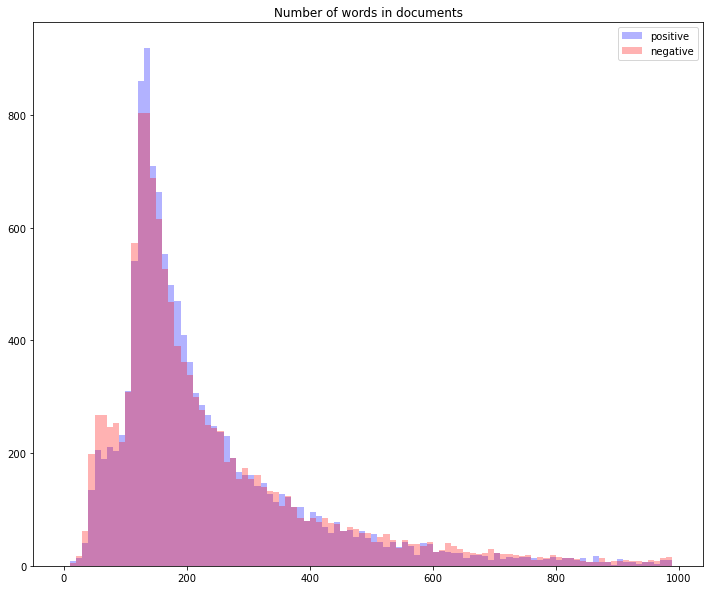
Padding#
From the length-distribution above, we infer that a MAX_SEQUENCE_LENGTH of 600 may be appropriate.
MAX_SEQUENCE_LENGTH = 600 # all text-sequences are padded to this length
x_train = pad_sequences(x_train, maxlen=MAX_SEQUENCE_LENGTH)
x_test = pad_sequences(x_test, maxlen=MAX_SEQUENCE_LENGTH)
print("Training data shape: ",x_train.shape)
print("Test data shape: ",x_test.shape)
Training data shape: (25000, 600)
Test data shape: (25000, 600)
Load Glove word-embeddings#
Glove word embeddings can be downloaded from https://nlp.stanford.edu/projects/glove/. In the following code-cell the variable GLOVE_DIR points to the directory, to which the downloaded embeddings has been extracted. The embeddings are loaded only if the GLOVE-parameter has been set to True before:
if GLOVE:
import os
from gensim.test.utils import datapath, get_tmpfile
from gensim.models import KeyedVectors
from gensim.scripts.glove2word2vec import glove2word2vec
GLOVE_DIR = '/Users/johannes/DataSets/Gensim/glove/'
glove_file = datapath(os.path.join(GLOVE_DIR, 'glove.6B.100d.txt'))
tmp_file = get_tmpfile(os.path.join(GLOVE_DIR, 'test_word2vec.txt'))
_ = glove2word2vec(glove_file, tmp_file)
w2vmodel = KeyedVectors.load_word2vec_format(tmp_file)
EMBEDDING_DIM=100
print('Total %d word vectors in Glove 6B 100d.' % w2vmodel.vectors.shape[0])
print('Length of word vectors in Glove 6B 100d: %d' % w2vmodel.vectors.shape[1])
Fasttext word embeddings can be downloaded from https://fasttext.cc/docs/en/crawl-vectors.html. In the following code-cell the directory, which is passed to KeyedVectors.load_word2vec_format(directory) is the directory, to which the downloaded embeddings has been extracted. The embeddings are loaded only if the FASTTEXT-parameter has been set to True before:
if FASTTEXT:
from gensim.models import KeyedVectors
# Creating the model
iMacPath="/Users/johannes/DataSets/nlp/wiki-news-300d-1M.vec"
pathMacBook='/Users/maucher/DataSets/Gensim/FastText/fasttextEnglish300.vec'
pathDeepLearn='../../DataSets/FastText/fasttextEnglish300.vec'
w2vmodel = KeyedVectors.load_word2vec_format(iMacPath)
EMBEDDING_DIM=w2vmodel.vector_size
As described above, if either GLOVE or FASTTEXT is True, then a pretrained word-embedding shall be applied in the Neural Networks, which are configured below. In this case an embedding_matrix must be prepared, which is applied in the Embedding-layer of the Neural Networks:
if USE_PRETRAINED:
# prepare embedding matrix
num_words = min(MAX_NB_WORDS, len(wordIndex))
embedding_matrix = np.zeros((num_words, EMBEDDING_DIM))
count=0
for (word, i) in wordIndexList[:MAX_NB_WORDS]:
try:
embedding_vector = w2vmodel[word]
if embedding_vector is not None and i < MAX_NB_WORDS:
embedding_matrix[i] = embedding_vector
except:
#print("{} not in wordembedding".format(word))
count+=1
continue
print("Number of word-embeddings with no vector in the given embedding: ",count)
Number of word-embeddings with no vector in the given embedding: 1899
CNN with only one layer#
In the following code-cell the embedding layer is defined. This layer is then applied as first layer in the Neural Networks below. In row
weights= [embedding_matrix] if USE_PRETRAINED else None,
the embedding-layer is defined such that a pretrained embedding_matrix is applied, if either GLOVE or FASTTEXT is True. Otherwise the embedding is learned from scratch in the document-classification task. In both cases the weights in this layer are learned, because trainable is set to be True.
embedding_layer = Embedding(MAX_NB_WORDS,
EMBEDDING_DIM,
weights= [embedding_matrix] if USE_PRETRAINED else None,
input_length=MAX_SEQUENCE_LENGTH,
trainable=True)
Next, the architecture of the CNN is defined. Note that the first layer in this architecture is the embedding_layer.
The first network architecture consists of
an embedding layer. This layer takes sequences of integers and learns word-embeddings. The sequences of word-embeddings are then passed to the first convolutional layer
one 1D-convolutional layer, which applies filters of size 5 and learns 128 features in parallel
one Max-Pooling layer to reduce the number of neurons, required in the following layers
a MLP classifier with Dropout and one hidden layer and the output layer
sequence_input = Input(shape=(MAX_SEQUENCE_LENGTH,), dtype='int32')
embedded_sequences = embedding_layer(sequence_input)
l_cov1= Conv1D(128, 5, activation='relu')(embedded_sequences)
l_pool3 = MaxPooling1D(5)(l_cov1)
l_flat = Flatten()(l_pool3)
l_drop1 = Dropout(0.2)(l_flat)
l_dense = Dense(180, activation='relu')(l_drop1)
l_drop2 = Dropout(0.2)(l_dense)
preds = Dense(1, activation='sigmoid')(l_drop2)
model = Model(sequence_input, preds)
Compile the model by defining training-parameters and display a summary of the architecture:
model.compile(loss='binary_crossentropy',
optimizer='ADAM',
metrics=['accuracy'])
model.summary()
Model: "model"
_________________________________________________________________
Layer (type) Output Shape Param #
=================================================================
input_1 (InputLayer) [(None, 600)] 0
_________________________________________________________________
embedding (Embedding) (None, 600, 300) 6000000
_________________________________________________________________
conv1d (Conv1D) (None, 596, 128) 192128
_________________________________________________________________
max_pooling1d (MaxPooling1D) (None, 119, 128) 0
_________________________________________________________________
flatten (Flatten) (None, 15232) 0
_________________________________________________________________
dropout (Dropout) (None, 15232) 0
_________________________________________________________________
dense (Dense) (None, 180) 2741940
_________________________________________________________________
dropout_1 (Dropout) (None, 180) 0
_________________________________________________________________
dense_1 (Dense) (None, 1) 181
=================================================================
Total params: 8,934,249
Trainable params: 8,934,249
Non-trainable params: 0
_________________________________________________________________
Perform training:
print("model fitting - simplified convolutional neural network")
history=model.fit(x_train, y_train, validation_data=(x_test, y_test),epochs=3, batch_size=128)
model fitting - simplified convolutional neural network
Epoch 1/3
196/196 [==============================] - 99s 496ms/step - loss: 0.7062 - accuracy: 0.5146 - val_loss: 0.4971 - val_accuracy: 0.7536
Epoch 2/3
196/196 [==============================] - 98s 499ms/step - loss: 0.3541 - accuracy: 0.8470 - val_loss: 0.3387 - val_accuracy: 0.8528
Epoch 3/3
196/196 [==============================] - 98s 500ms/step - loss: 0.1340 - accuracy: 0.9522 - val_loss: 0.3855 - val_accuracy: 0.8493
acc = history.history['accuracy']
val_acc = history.history['val_accuracy']
max_val_acc=np.max(val_acc)
epochs = range(1, len(acc) + 1)
plt.figure(figsize=(10,8))
plt.grid(True)
plt.plot(epochs, acc, 'bo-', label='Training accuracy')
plt.plot(epochs, val_acc, 'ro-', label='Validation accuracy')
plt.title('Training and validation accuracy')
plt.xlabel("Epoch")
plt.ylabel("Accuracy")
plt.legend()
plt.show()
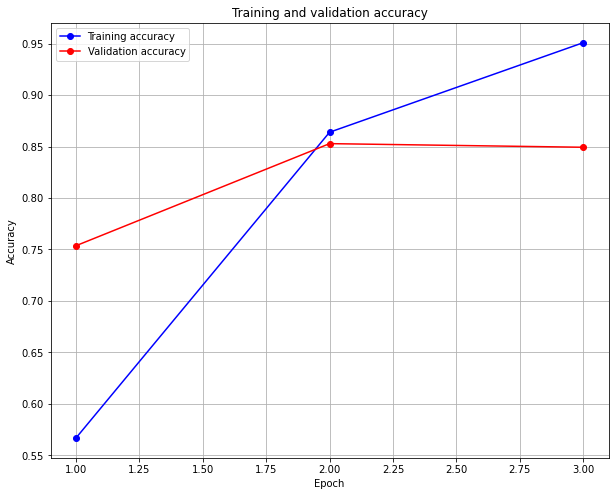
CNN with 3 Convolutional Layers#
embedding_layer = Embedding(MAX_NB_WORDS,
EMBEDDING_DIM,
weights= [embedding_matrix] if USE_PRETRAINED else None,
input_length=MAX_SEQUENCE_LENGTH,
trainable=True)
sequence_input = Input(shape=(MAX_SEQUENCE_LENGTH,), dtype='int32')
embedded_sequences = embedding_layer(sequence_input)
l_cov1= Conv1D(64, 3, activation='relu')(embedded_sequences)
l_cov2 = Conv1D(32, 3, activation='relu')(l_cov1)
l_cov3 = Conv1D(16, 3, activation='relu')(l_cov2)
l_flat = Flatten()(l_cov3)
l_drop1 = Dropout(0.2)(l_flat)
l_dense = Dense(180, activation='relu')(l_drop1)
l_drop2 = Dropout(0.2)(l_dense)
preds = Dense(1, activation='sigmoid')(l_drop2)
model = Model(sequence_input, preds)
model.compile(loss='binary_crossentropy',
optimizer='ADAM',
metrics=['accuracy'])
model.summary()
Model: "model_1"
_________________________________________________________________
Layer (type) Output Shape Param #
=================================================================
input_2 (InputLayer) [(None, 600)] 0
_________________________________________________________________
embedding_1 (Embedding) (None, 600, 300) 6000000
_________________________________________________________________
conv1d_1 (Conv1D) (None, 598, 64) 57664
_________________________________________________________________
conv1d_2 (Conv1D) (None, 596, 32) 6176
_________________________________________________________________
conv1d_3 (Conv1D) (None, 594, 16) 1552
_________________________________________________________________
flatten_1 (Flatten) (None, 9504) 0
_________________________________________________________________
dropout_2 (Dropout) (None, 9504) 0
_________________________________________________________________
dense_2 (Dense) (None, 180) 1710900
_________________________________________________________________
dropout_3 (Dropout) (None, 180) 0
_________________________________________________________________
dense_3 (Dense) (None, 1) 181
=================================================================
Total params: 7,776,473
Trainable params: 7,776,473
Non-trainable params: 0
_________________________________________________________________
print("model fitting - simplified convolutional neural network")
history=model.fit(x_train, y_train, validation_data=(x_test, y_test),epochs=3, batch_size=128)
model fitting - simplified convolutional neural network
Epoch 1/3
196/196 [==============================] - 73s 371ms/step - loss: 0.6934 - accuracy: 0.5080 - val_loss: 0.5995 - val_accuracy: 0.6633
Epoch 2/3
196/196 [==============================] - 71s 362ms/step - loss: 0.3671 - accuracy: 0.8338 - val_loss: 0.3212 - val_accuracy: 0.8644
Epoch 3/3
196/196 [==============================] - 71s 360ms/step - loss: 0.1414 - accuracy: 0.9485 - val_loss: 0.3417 - val_accuracy: 0.8664
acc = history.history['accuracy']
val_acc = history.history['val_accuracy']
max_val_acc=np.max(val_acc)
epochs = range(1, len(acc) + 1)
plt.figure(figsize=(10,8))
plt.grid(True)
plt.plot(epochs, acc, 'bo-', label='Training accuracy')
plt.plot(epochs, val_acc, 'ro-', label='Validation accuracy')
plt.title('Training and validation accuracy')
plt.xlabel("Epoch")
plt.ylabel("Accuracy")
plt.legend()
plt.show()
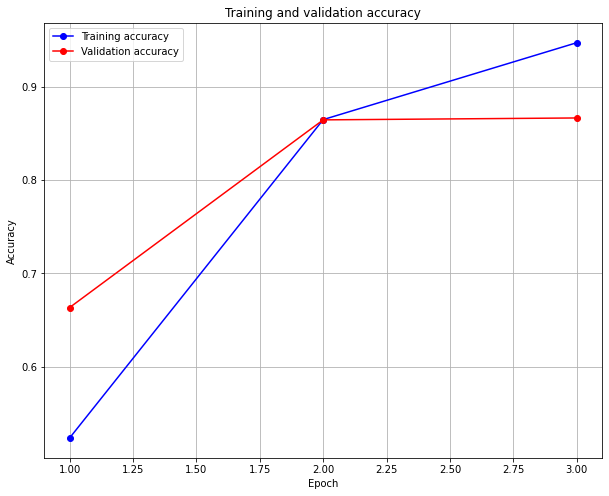
CNN with different filter sizes in one layer#
In Y. Kim; Convolutional Neural Networks for Sentence Classification a CNN with different filter-sizes in one layer has been proposed. This CNN is implemented below:
Source: Y. Kim; Convolutional Neural Networks for Sentence Classification
embedding_layer = Embedding(MAX_NB_WORDS,
EMBEDDING_DIM,
weights= [embedding_matrix] if USE_PRETRAINED else None,
input_length=MAX_SEQUENCE_LENGTH,
trainable=True)
convs = []
filter_sizes = [3,4,5]
sequence_input = Input(shape=(MAX_SEQUENCE_LENGTH,), dtype='int32')
embedded_sequences = embedding_layer(sequence_input)
for fsz in filter_sizes:
l_conv = Conv1D(filters=128,kernel_size=fsz,activation='relu')(embedded_sequences)
l_pool = MaxPooling1D(5)(l_conv)
convs.append(l_pool)
l_merge = Concatenate(axis=1)(convs)
l_cov1= Conv1D(128, 5, activation='relu')(l_merge)
l_pool1 = MaxPooling1D(5)(l_cov1)
l_cov2 = Conv1D(128, 5, activation='relu')(l_pool1)
l_pool2 = MaxPooling1D(30)(l_cov2)
l_flat = Flatten()(l_pool2)
l_dense = Dense(128, activation='relu')(l_flat)
preds = Dense(1, activation='sigmoid')(l_dense)
model = Model(sequence_input, preds)
model.compile(loss='binary_crossentropy',
optimizer='ADAM',
metrics=['accuracy'])
print("model fitting - more complex convolutional neural network")
model.summary()
history=model.fit(x_train, y_train, validation_data=(x_test, y_test),
epochs=3, batch_size=128)
model fitting - more complex convolutional neural network
Model: "model_2"
__________________________________________________________________________________________________
Layer (type) Output Shape Param # Connected to
==================================================================================================
input_3 (InputLayer) [(None, 600)] 0
__________________________________________________________________________________________________
embedding_2 (Embedding) (None, 600, 300) 6000000 input_3[0][0]
__________________________________________________________________________________________________
conv1d_4 (Conv1D) (None, 598, 128) 115328 embedding_2[0][0]
__________________________________________________________________________________________________
conv1d_5 (Conv1D) (None, 597, 128) 153728 embedding_2[0][0]
__________________________________________________________________________________________________
conv1d_6 (Conv1D) (None, 596, 128) 192128 embedding_2[0][0]
__________________________________________________________________________________________________
max_pooling1d_1 (MaxPooling1D) (None, 119, 128) 0 conv1d_4[0][0]
__________________________________________________________________________________________________
max_pooling1d_2 (MaxPooling1D) (None, 119, 128) 0 conv1d_5[0][0]
__________________________________________________________________________________________________
max_pooling1d_3 (MaxPooling1D) (None, 119, 128) 0 conv1d_6[0][0]
__________________________________________________________________________________________________
concatenate (Concatenate) (None, 357, 128) 0 max_pooling1d_1[0][0]
max_pooling1d_2[0][0]
max_pooling1d_3[0][0]
__________________________________________________________________________________________________
conv1d_7 (Conv1D) (None, 353, 128) 82048 concatenate[0][0]
__________________________________________________________________________________________________
max_pooling1d_4 (MaxPooling1D) (None, 70, 128) 0 conv1d_7[0][0]
__________________________________________________________________________________________________
conv1d_8 (Conv1D) (None, 66, 128) 82048 max_pooling1d_4[0][0]
__________________________________________________________________________________________________
max_pooling1d_5 (MaxPooling1D) (None, 2, 128) 0 conv1d_8[0][0]
__________________________________________________________________________________________________
flatten_2 (Flatten) (None, 256) 0 max_pooling1d_5[0][0]
__________________________________________________________________________________________________
dense_4 (Dense) (None, 128) 32896 flatten_2[0][0]
__________________________________________________________________________________________________
dense_5 (Dense) (None, 1) 129 dense_4[0][0]
==================================================================================================
Total params: 6,658,305
Trainable params: 6,658,305
Non-trainable params: 0
__________________________________________________________________________________________________
Epoch 1/3
196/196 [==============================] - 259s 1s/step - loss: 0.6787 - accuracy: 0.5269 - val_loss: 0.3261 - val_accuracy: 0.8576
Epoch 2/3
196/196 [==============================] - 253s 1s/step - loss: 0.2464 - accuracy: 0.9005 - val_loss: 0.3160 - val_accuracy: 0.8661
Epoch 3/3
196/196 [==============================] - 259s 1s/step - loss: 0.0991 - accuracy: 0.9678 - val_loss: 0.4194 - val_accuracy: 0.8430
acc = history.history['accuracy']
val_acc = history.history['val_accuracy']
max_val_acc=np.max(val_acc)
epochs = range(1, len(acc) + 1)
plt.figure(figsize=(10,8))
plt.grid(True)
plt.plot(epochs, acc, 'bo-', label='Training accuracy')
plt.plot(epochs, val_acc, 'ro-', label='Validation accuracy')
plt.title('Training and validation accuracy')
plt.xlabel("Epoch")
plt.ylabel("Accuracy")
plt.legend()
plt.show()
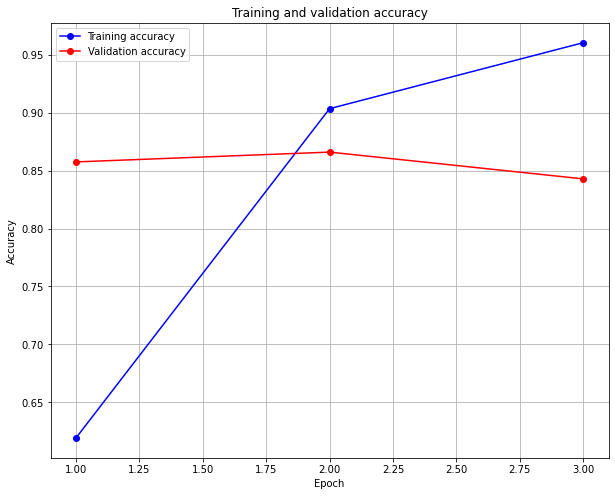
LSTM text classification#
Define LSTM architecture#
EMBEDDING_DIM=300
embedding_layer = Embedding(MAX_NB_WORDS,
EMBEDDING_DIM,
#weights= [embedding_matrix] if USE_PRETRAINED else None,
input_length=MAX_SEQUENCE_LENGTH,
trainable=True)
print("Number of words in each input: ",MAX_SEQUENCE_LENGTH)
# train a 1D convnet with global maxpooling
sequence_input = Input(shape=(MAX_SEQUENCE_LENGTH,), dtype='int32')
embedded_sequences = embedding_layer(sequence_input)
sequence_input = Input(shape=(MAX_SEQUENCE_LENGTH,), dtype='int32')
embedded_sequences = embedding_layer(sequence_input)
x = LSTM(units=32)(embedded_sequences)
x = Dropout(0.3)(x)
preds = Dense(1,activation='sigmoid')(x)
model = Model(sequence_input, preds)
model.summary()
Number of words in each input: 600
Model: "model"
_________________________________________________________________
Layer (type) Output Shape Param #
=================================================================
input_2 (InputLayer) [(None, 600)] 0
_________________________________________________________________
embedding (Embedding) (None, 600, 300) 6000000
_________________________________________________________________
lstm (LSTM) (None, 32) 42624
_________________________________________________________________
dropout (Dropout) (None, 32) 0
_________________________________________________________________
dense (Dense) (None, 1) 33
=================================================================
Total params: 6,042,657
Trainable params: 6,042,657
Non-trainable params: 0
_________________________________________________________________
Training#
model.compile(loss='binary_crossentropy', optimizer='adam', metrics=['accuracy'])
history=model.fit(x_train, y_train,
batch_size=128,
epochs=3,
validation_data=(x_test, y_test))
Epoch 1/3
196/196 [==============================] - 114s 578ms/step - loss: 0.4650 - accuracy: 0.7738 - val_loss: 0.4584 - val_accuracy: 0.7820
Epoch 2/3
196/196 [==============================] - 113s 578ms/step - loss: 0.2274 - accuracy: 0.9160 - val_loss: 0.3440 - val_accuracy: 0.8649
Epoch 3/3
196/196 [==============================] - 114s 580ms/step - loss: 0.1464 - accuracy: 0.9507 - val_loss: 0.4074 - val_accuracy: 0.8451
acc = history.history['accuracy']
val_acc = history.history['val_accuracy']
max_val_acc=np.max(val_acc)
epochs = range(1, len(acc) + 1)
plt.figure(figsize=(10,8))
plt.grid(True)
plt.plot(epochs, acc, 'bo-', label='Training accuracy')
plt.plot(epochs, val_acc, 'ro-', label='Validation accuracy')
plt.title('Training and validation accuracy')
plt.xlabel("Epoch")
plt.ylabel("Accuracy")
plt.legend()
plt.show()
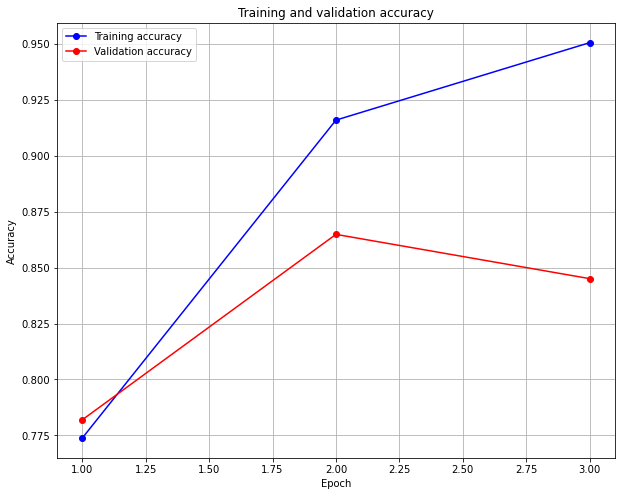
print("Maximum accuracy: ",max_val_acc)
Maximum accuracy: 0.8649200201034546
Result:
In this task all the Neural Network architectures, which have implemented in this notebook, yield similar accuracy-values. However, in this notebook training has been limited to 3 epochs. Actually the networks should be trained longer. Moreover, no optimisation of hyperparameters (e.g. training-parameters) has been employed here.
Appendix: Text Preprocessing with Keras#
In the example of this notebook text access and preprocessing has been simple, because a corpus from keras in which texts are already presented in a format, which can directly be passed to the input of Keras Neural Networks.
In real applications text corpora are usually provided as lists of strings. For example:
textcorpus = ["This is the first document",
"The second document contains this text",
"And here is a third document"]
textcorpus
['This is the first document',
'The second document contains this text',
'And here is a third document']
As shown above, we need to transform this list of strings into a list of integer-lists, where each integer-list is a sequence indices of the words in the corresponding text.
This transformation can efficiently be implemented by the Tokenizer-class of the tensorflow.keras.preprocessing.text-module as shown below:
from tensorflow.keras.preprocessing.text import Tokenizer
tokenizer = Tokenizer()
tokenizer.fit_on_texts(textcorpus)
tokenizer.texts_to_sequences(textcorpus)
[[2, 3, 4, 5, 1], [4, 6, 1, 7, 2, 8], [9, 10, 3, 11, 12, 1]]
Below other useful attributes and methods, provided by the trained Tokenizer-class are demonstrated:
# print the attributes for the text and encode the doucment
print("\nTerm frequencies (How often do the individual terms occur in the corpus?):")
print(tokenizer.word_counts)
print("\nIn how much documents do the individual terms occur? :")
print(tokenizer.word_docs)
print("\nThe word index:")
print(tokenizer.word_index)
print("\nHow many documents are there?")
print(tokenizer.document_count)
print("\nBoW matrix:")
encoded_text = tokenizer.texts_to_matrix(textcorpus)
encoded_text
Term frequencies (How often do the individual terms occur in the corpus?):
OrderedDict([('this', 2), ('is', 2), ('the', 2), ('first', 1), ('document', 3), ('second', 1), ('contains', 1), ('text', 1), ('and', 1), ('here', 1), ('a', 1), ('third', 1)])
In how much documents do the individual terms occur? :
defaultdict(<class 'int'>, {'the': 2, 'this': 2, 'is': 2, 'first': 1, 'document': 3, 'second': 1, 'contains': 1, 'text': 1, 'third': 1, 'here': 1, 'a': 1, 'and': 1})
The word index:
{'document': 1, 'this': 2, 'is': 3, 'the': 4, 'first': 5, 'second': 6, 'contains': 7, 'text': 8, 'and': 9, 'here': 10, 'a': 11, 'third': 12}
How many documents are there?
3
BoW matrix:
array([[0., 1., 1., 1., 1., 1., 0., 0., 0., 0., 0., 0., 0.],
[0., 1., 1., 0., 1., 0., 1., 1., 1., 0., 0., 0., 0.],
[0., 1., 0., 1., 0., 0., 0., 0., 0., 1., 1., 1., 1.]])

